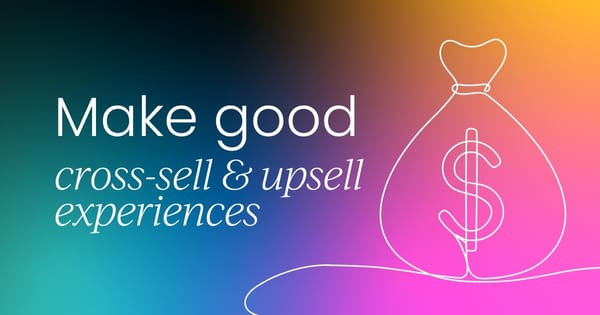When working closely with customers, there can come times when your business demands seem at odds with customer desires. On the same day, you can have higher-ups wanting you to focus on growing sales figures and customers complaining about “too much sales talk”.
So how does one balance these two needs? It’s often a difficult balance to meet especially if you’ve got priorities that seem at odds with one another.
Cross-selling and upselling it a vital part of customer marketing, and doing so well will ensure customer relationships remain strong. In this article we’ll be going through:
- The psychology of sales, including the role of reciprocity and choice architecture
- Steps to making cross-sell and upsell a good experience
Understanding Customer Psychology in Sales
To understand how best to conduct sales without compromising customer trust and investment, you have to understand how customer brains work and what attracts and repels customers when money is involved.
The role of reciprocity
How does this translate in sales? When you offer things like free samples, community spaces, or offers, customers are more likely to want to make more purchases to reciprocate. More specifically this can be things like:
- Offering free samples or trials: Providing a free trial or sample of your product can make customers feel indebted and more likely to buy.
- Giving gifts: A small gift, like a pen or notepad, can be a cheap and effective way to open conversations with sales leads.
- Being an active listener: Active listening can help create positive feelings of reciprocity.
- Showing empathy: Demonstrate empathy and a willingness to help.
When consumers receive something of value, they feel an implicit obligation to reciprocate, even if the initial gesture was unsolicited. This sense of obligation can drive them to make a purchase.
Small initial commitments, like signing up for a newsletter, can lead to larger reciprocal actions, such as making a purchase, to maintain consistency with previous engagements.
Specifically, things like timed discounts or seasonal offers combine both reciprocity and urgency. Leveraging scarcity and urgency can activate the reciprocity principle to make consumers act quickly to "repay" the seller for the opportunity.

The role of choice architecture
Going hand in hand with reciprocity, choice architecture can make these acts more consistent and frequent.
Consumers tend to choose the "default" or easiest option, often what they're accustomed to buying. This minimizes the cognitive effort of choosing. Consumers also focus more on short-term benefits. This can be leveraged through:
- Presenting the desired choice as the default
- Reducing alternative options
- Using special offers and encouragement for the preferred choice
- Advertising and campaigns to influence behavior
- Modifying product packaging
The key is designing the "choice architecture" to subtly nudge consumers towards certain options.
Steps to a good cross/upsell experience
So, when part of your aim is to keep customers with your company by offering complimentary and/or premium products, how do you do so without it feeling too sales-y or out of the blue?

Create moments of genuine value
Build on Trust, Not Tactics The days of aggressive, high-pressure sales tactics are over.
Modern customers are savvier and more resistant to overt attempts to get them to buy more. Instead, focus on building genuine trust and rapport.
Provide value upfront, understand their needs, and make relevant recommendations - don't just try to hit a quota. Customer trust is the foundation of successful cross-selling.
The best way to do this is to understand why the customer has chosen your company in the first place. Is it the way you interact with them on social media? Is it the unique features your product offers? Is it the community of customers around you?
People will choose to come to you and stay with you for different reasons and knowing what these are will give you a better understanding of what other products might suit them and their needs.
The timing principle: when customers are most receptive
Time It Right - Timing is critical. Identify the optimal moments when customers are most receptive to relevant offers.
This could be after they've just had a positive interaction, when they're exploring new products, or when they're about to make a purchase.
Avoid interrupting workflows or decision-making processes. Make the offer feel like a natural next step, not an unwanted intrusion.
Frame offers as solutions rather than sales
Frame It as a Solution, Not a Sale - Rather than pitching an upsell as a way to spend more money, reframe it as a solution to a problem or a way to get more value.
For example, instead of "Would you like to add our premium package?", try "Based on your usage, our premium package would give you X, Y, and Z benefits that I think you'd find really valuable."
Focus on how the offer solves a need, not just the sale.
Build trust through personalization and relevance
Personalize, Personalize, Personalize - Customers expect a personalized experience. Use data and past interactions to understand their preferences, behaviors, and pain points.
Make cross-sell/upsell recommendations that are tailored to their individual needs. This not only increases the chances of conversion but also demonstrates that you truly understand the customer, further building trust.
Conclusion
To effectively leverage cross-selling and upselling strategies without compromising customer trust, businesses must focus on providing genuine value, building long-term relationships, and tailoring offers to individual customer needs.
By understanding consumer psychology, implementing thoughtful choice architecture, and timing recommendations appropriately, companies can enhance the customer experience while driving incremental revenue.
The key is to prioritize the customer's interests, not just short-term sales goals, to cultivate loyalty and sustainable growth.
The one thing we can never truely know is what goes on in our customers' minds. But becoming a master of consumer psychology brings us very close.
With Consumer Psychology Certified you’ll have the support of a consumer psychology expert, and a ton of other resources to make you a connoisseur of customer psychology.


 5 min read
5 min read
 Follow us on LinkedIn
Follow us on LinkedIn





